
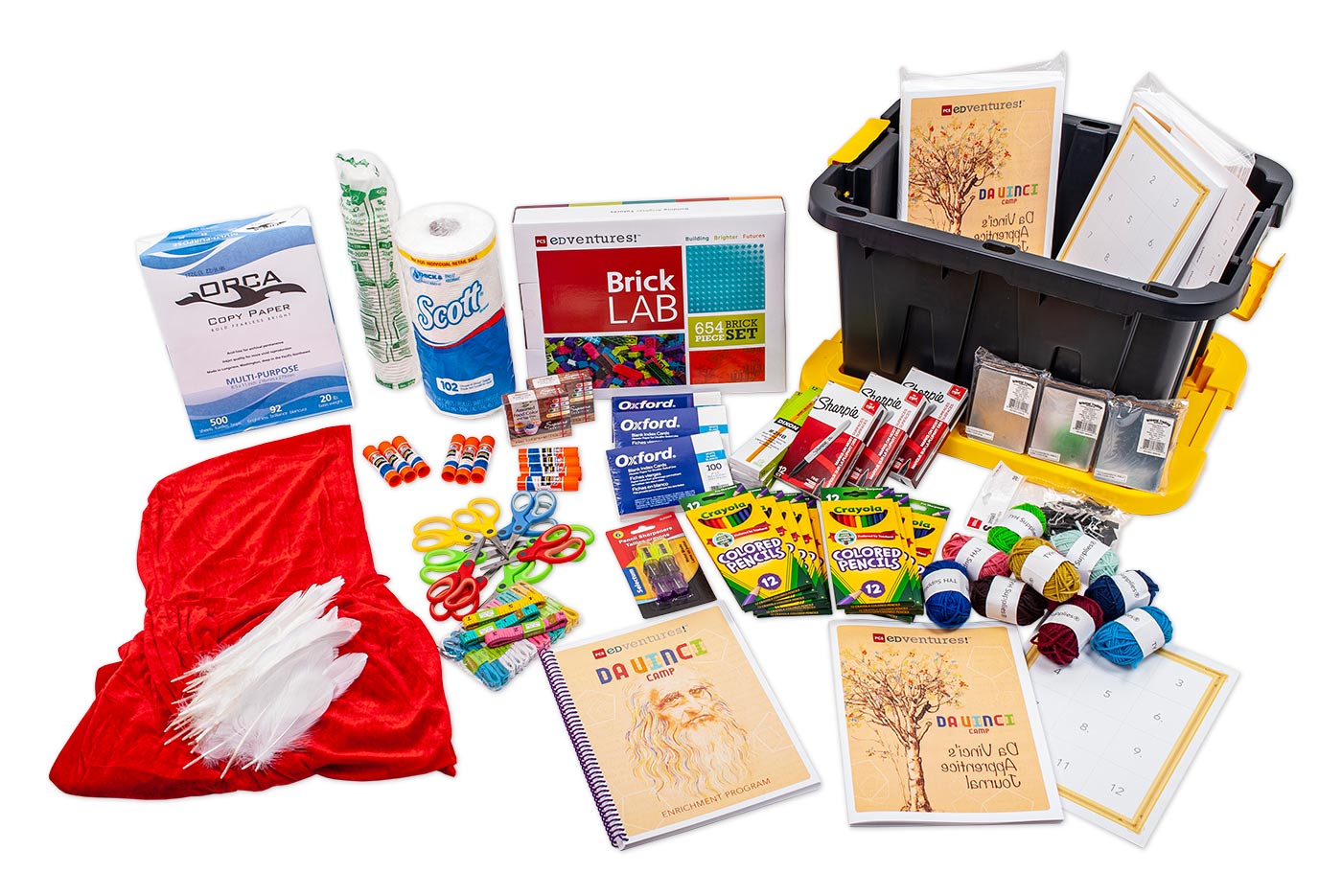
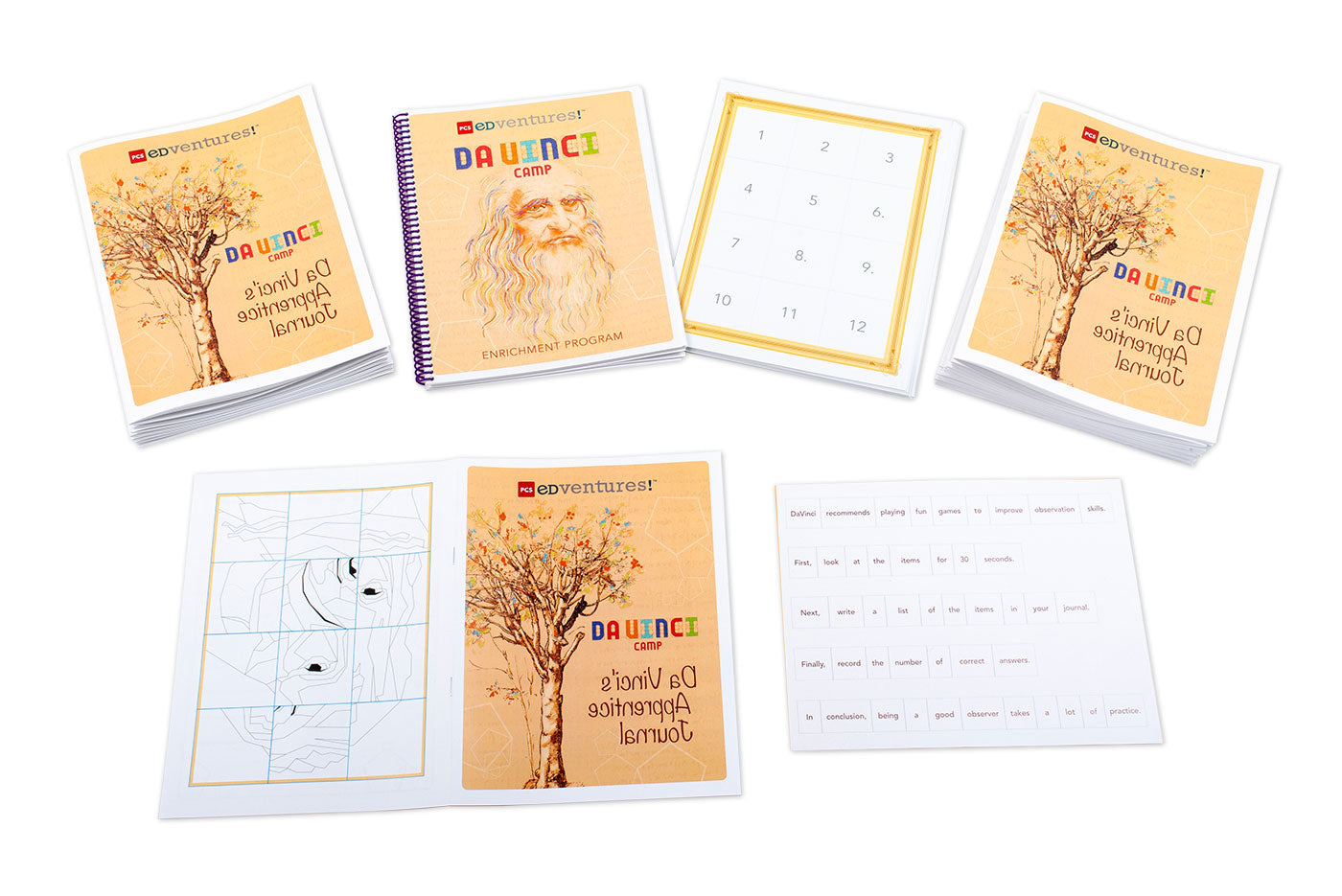
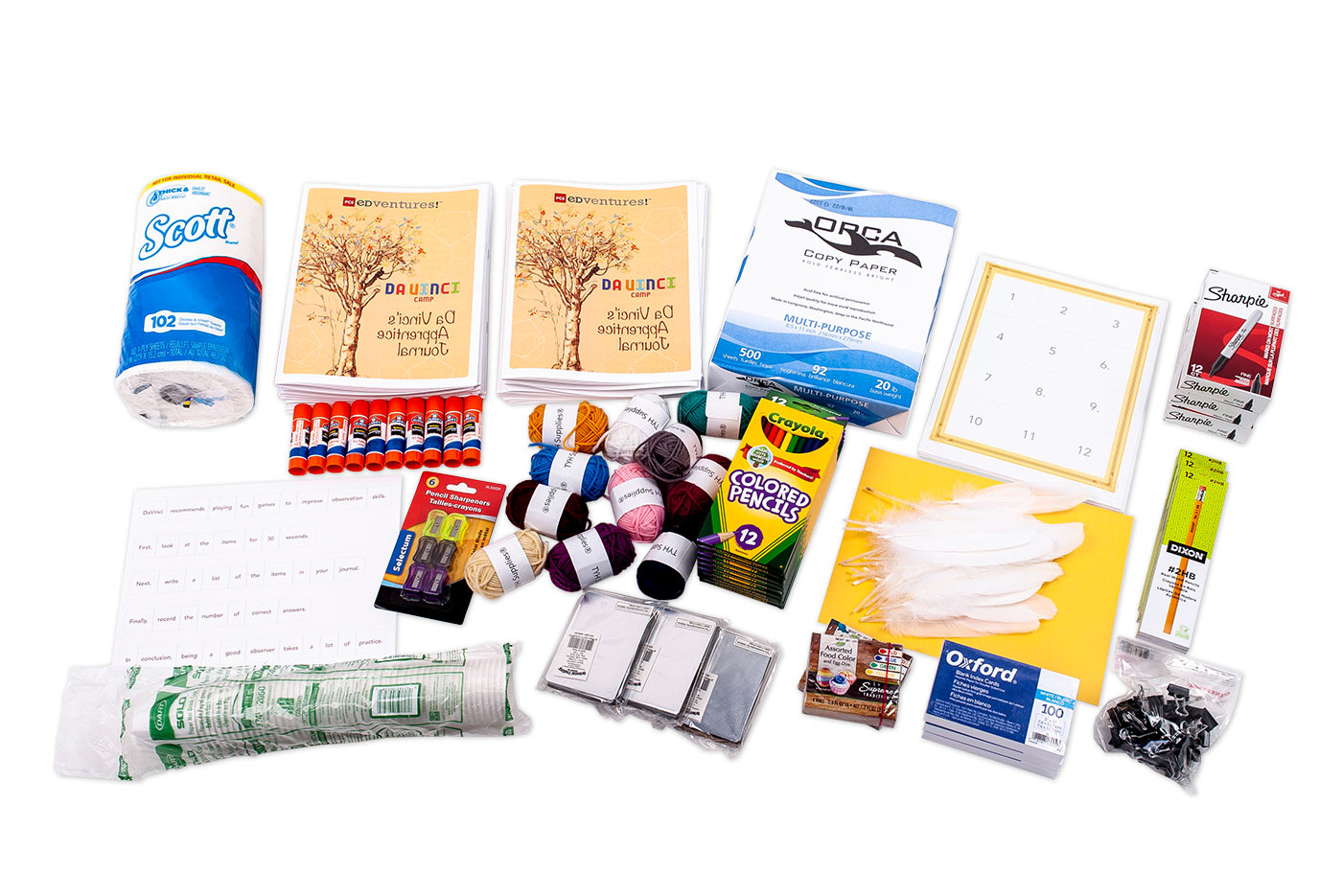
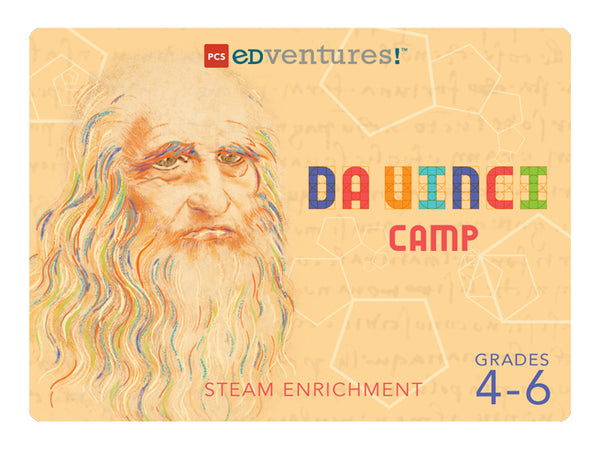
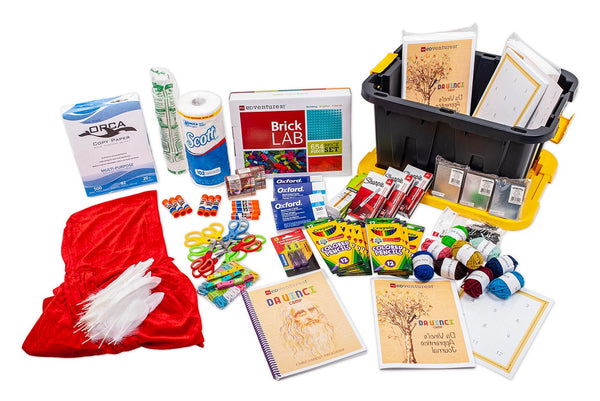
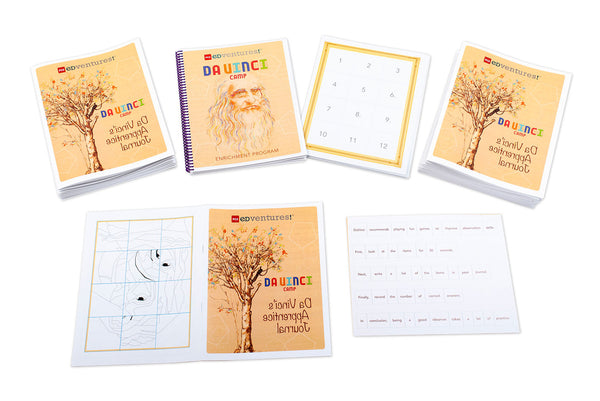
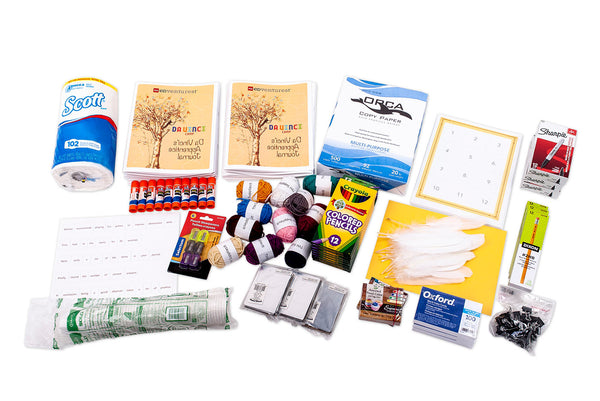






Da Vinci Camp
- Sale price
- 625 USD
- List price
- 665 USD
- You save
- 40 USD (7%)
Dare to be Like Da Vinci!
Time travel to reveal how Leonardo Da Vinci’s inquisitiveness inspired many of today’s advancements from art to zoology. Learners begin their STEAM journey as apprentices and graduate to Journeypersons. Along the way, they meet Leonardo Da Vinci and engage in hands-on activities that promote creativity, multi-subject integration and collaborative learning. Learners experiment with mirror writing, observe patterns, reveal anatomical proportions and create masterpieces fit for a king. Most importantly, they develop a deeper understanding of the interconnectedness of the world simply by asking, “I wonder why..."
Grades: 4-6
Students: Up to 30
Contact Hours: 12+
Subject Targets:
Art/STEAM, Math Connections, English Language Arts Connections, Social Studies/History Connections
Reusability:
- Refill Kit Available: This product offers affordable consumable refill kits. See the materials tab for details.
Settings & Tech Requirements
Recommended Settings:
- Summer Camps
- Classrooms
- Out-of-School Time Programs
- Home Learning
Tech Requirements:
- None
Curriculum Topics
Each Activity Guide Includes:
- Schedule
- Opening & Closing Discussion
- Step-By-Step Activity Instructions
- Topic Background & Vocabulary
- Optional Extension Activities
Curriculum Topics:
- What’s in a Name?
- Mirror Writing
- How to be a Better Observer
- Fractals
- Universal Emotions
- How to Draw a Selfie
- Emoji Story Books
- Woodpeckers
- Alligators
- 3 Perspectives in Cartography
- Ideal City Design
- Mystery Masterpiece Reveal
Professional Development
Product Orientation:
- Half hour free webinar orientation for purchases of $500+
- One hour free webinar orientation for purchases of $1000+
- Additional training available for purchase
Materials
Complete Program Includes:
- Instructor Guide: 1
- Student Journals: 31
- Balls of Yarn: 10
- Binder Clips (36 pack): 1
- BrickLAB BrickPack: 1
- Cape: 1
- Colored Pencils (12 pack): 10
- Copy Paper: (500 sheets): 1
- Feathers: 32
- Food Coloring Packs: 2
- Glue Sticks: 10
- Index Cards (100 pack): 3
- Mirrors: 36
- Rolls of Paper Towels: 1
- Paper Cups: 50
- Pencil Sharpeners: 6
- Pencils (12 pack): 3
- Permanent Markers: 36
- Scissors: 10
- Tape Measures: 15
- Access to the Digital Resource Portal
Curriculum Printed & Digital Includes:
- Instructor Guide: 1
- Student Journals: 31
- How to Be a Better Observer Template: 1
- Picture Frame: 31
- Access to the Digital Resource Portal
Refill Kit Available:
Looking to use your Da Vinci Camp Enrichment Program with the next group of apprentices? This refill kit will get them up and running in no time!
- Balls of Yarn: 10
- Binder Clips (36 pack): 1
- Copy Paper (500 sheets): 1
- Feathers: 32
- Food Coloring Packs: 2
- Glue Sticks: 10
- Index Cards (100 pack): 3
- Mirrors: 36
- Roll of Paper Towels: 1
- Colored Pencils (12 pack): 10
- Paper Cups: 50
- Pencil Sharpeners: 6
- Pencils (12 pack): 3
- Permanent Markers: 36
- Scissors: 10
Standards & Alignment
Habits of Mind:
16 thinking habits developed by Art Costa and Bena Kallick to empower students to succeed in a 21st-century learning environment.
- Persisting
- Managing Impulsivity
- Listening with Understanding and Empathy
- Thinking Flexibly
- Thinking about Thinking
- Striving for Accuracy
- Questioning and Posing Problems
- Applying Past Knowledge to New Situations
- Thinking and Communicating with Clarity and Precision
- Gathering Data through All Senses 9
- Creating, Imagining, Innovating
- Responding with Wonderment and Awe
- Taking Responsible Risks
- Finding Humor
- Thinking Interdependently
21st Century Skills:
A set of widely-applicable abilities essential for success in the information age.
- Creativity and Innovation
- Critical Thinking and Problem Solving
- Communication and Collaboration
- Information, Media, and Technology Literacy
- Flexibility and Adaptability
- Initiative and Self-Direction
- Social and Cross-Cultural Skills
- Productivity and Accountability
- Leadership and Responsibility
© 2019 Battelle for Kids. battelleforkids.org. All Rights Reserved. Battelle for Kids was not involved in the production of this product and does not endorse it.
Common Core State Standards for Mathematics:
- CCSS.MATH.CONTENT.4.G.A.1: Draw points, lines, line segments,
rays, angles (right, acute, obtuse), and perpendicular and parallel
lines. Identify these in two-dimensional figures. - CCSS.MATH.CONTENT.4.G.A.3: Recognize a line of symmetry for a
two-dimensional figure as a line across the figure such that the figure
can be folded along the line into matching parts. Identify
line-symmetric figures and draw lines of symmetry. - CCSS.MATH.CONTENT.4.MD.A.2: Use the four operations to solve word problems involving distances, intervals of time, liquid volumes, masses of objects, and money, including problems involving simple fractions or decimals, and problems that require expressing measurements given in a larger unit in terms of a smaller unit. Represent measurement quantities using diagrams such as number line diagrams that feature a measurement scale.
- CCSS.MATH.CONTENT.5.G.B.3: Understand that attributes belonging to a category of two-dimensional figures also belong to all subcategories of that category. For example, all rectangles have four right angles and squares are rectangles, so all squares have four right angles.
- CCSS.MATH.CONTENT.6.RP.A.1: Understand the concept of a ratio and use ratio language to describe a ratio relationship between two quantities.
© Copyright 2010. National Governors Association Center for Best Practices and Council of Chief State School Officers. All rights reserved.
Common Core State Standards for English Language Arts:
- CCSS.ELA-LITERACY.RF.4.3.A: Use combined knowledge of all letter-sound correspondences, syllabication patterns, and morphology (e.g., roots and affixes) to read accurately unfamiliar multisyllabic words in context and out of context.
- CCSS.ELA-READING LITERATURE.R.L.4.4: Determine the meaning of words and phrases as they are used in a text, including those that allude to significant characters found in mythology (e.g., Herculean).
- CCSS.ELA-LITERACY.SL.5.5: Include multimedia components (e.g., graphics, sound) and visual displays in presentations when appropriate to enhance the development of main ideas or themes.
© Copyright 2010. National Governors Association Center for Best Practices and Council of Chief State School Officers. All rights reserved.
Next Generation Science Standards:*
- NGSS MS-ETS1-3 Engineering Design
- NGSS MS-LS1-5 Growth and Development of Organisms
- NGSS 3-5-ETS1-1 Engineering Design
- NGSS 3-5-ETS1-2 Engineering Design
- NGSS 3-5-ETS1-3 Engineering Design
- NGSS 4-LS1-1 Structure and Function
*Next Generation Science Standards and NGSS is a registered trademark of WestEd. Neither WestEd nor the lead states and partners that developed the Next Generation Science Standards were involved in the production of this product, and do not endorse it.
National Core Arts Standards:
- VA:Cr1.1.4a: Brainstorm multiple approaches to a creative art or design problem.
- VA:Cr1.1.5a: Combine ideas to generate an innovative idea for art-making.
- VA:Cr1.1.6a: Combine concepts collaboratively to generate innovative ideas for creating art.
- VA:Cr1.2.4a: Collaboratively set goals and create artwork that is meaningful and has purpose to the makers.
- VA:Cr1.2.5a: Identify and demonstrate diverse methods of artistic investigation to choose an approach for beginning a work of art.
- VA:Cr1.2.6a: Formulate an artistic investigation of personally relevant content for creating art.
- VA:Cr2.1.4a: Explore and invent art-making techniques and approaches.
- VA:Cr2.1.5a: Experiment and develop skills in multiple art-making techniques and approaches through practice.
- VA:Cr2.3.6a: Design or redesign objects, places, or systems that meet the identified needs of diverse users.
- VA:Cr3.1.6a: Reflect on whether personal artwork conveys the intended meaning and revise accordingly.
National Core Arts Standards © 2015 National Coalition for Core Arts Standards. Rights administered by Young Audiences, Inc. New York, NY. https://www.nationalartsstandards.org
About the Author
Beth Schadd
Hailing from Wisconsin, Beth Schadd moved to Idaho in 2008 in search of adventure and a Master’s degree in Environmental Science and Education from the University of Idaho. As an educator, she has worked with children of all ages in the outdoors and the classroom, as well as coaching various sports.
Beth has developed experiential curriculum for science centers, museums, day camps, and outdoor programs. In 2013, she traveled to China to lead outdoor and adventure camps. Prior to moving to Idaho, Beth worked in labs studying mosquitoes and environmental health, and managed clinical trials. Though she will always be a Cheese Head at heart, she has embraced the great outdoors of the West, enjoying snowshoeing, mountain biking and backpacking, and has become an avid stand up
paddleboarder.
Shipping Information
Payment and Return Policy
Thank you for choosing PCS Edventures! We want to make your shopping experience with us a pleasant one. The following is our general policy concerning payment, returns, product shipping, and warranties.
Payment Information
We accept Purchase Orders (POs)*, checks, VISA, MasterCard, American Express, and Discover as forms of payment. During payment processing, we will verify your billing and shipping address. Please be sure that you enter your information accurately.
*Purchase Orders are subject to review by PCS Edventures. We reserve the right to accept or reject any Purchase Order at our discretion.
Shipping
PCS Edventures does not include the cost of shipping in its product pricing. Your shipping rate will depend on your delivery location.
We ship through Federal Express or United States Postal Service. Please provide a physical address for shipping. We are unable to ship to PO Boxes.
If your order requires expedited shipping, please contact our office at sales@edventures.com or (208) 343-3110.
Tax
Sales tax is automatically applied to any transaction that will ship to the states listed below. If you are tax exempt, please contact us at sales@edventures.com or (208) 343-3110.
Idaho: Sales tax is added, unless proper documentation for your exempt status is provided. This is required by the State of Idaho.
California: Sales tax is added to all transactions. This is required by the State of California.
Washington: Sales tax is added to all transactions. This is required by the State of Washington.
Georgia: Sales tax is added, unless proper documentation for your exempt status is provided. This is required by the State of Georgia.
New Jersey: Sales tax is added, unless proper documentation for your exempt status is provided. This is required by the State of New Jersey.
United States Customers: Please provide your organization’s Tax Identification Number or tax-exempt certification form as described in IRC Section 501 (c)(3) of the Code.
Order Fulfillment
Many products are assembled and packaged after an order is received. Typical order fulfillment time is 2-5 business days from your order date.
The products listed on our website contain materials that may be discontinued by our vendors without notice. Lead times to receive materials from our vendors may extend significantly due to a variety of factors. A sales representative will contact you within 48 hours if your order has been impacted by these issues or any other reason.
If your order requires expedited shipping, please contact our office at sales@edventures.com or (208) 343-3110 so we can try to accommodate your request. If you need delivery outside the continental United States, please contact us for shipping costs. We do not ship to PO Boxes.
Partial Fulfillment
PCS Edventures products are designed to be ready-to-use and accessible for any educator. This often requires some components to be sourced from third-party vendors. Occasionally, this may cause delays in order fulfillment.
In such cases, orders may be partially fulfilled to meet deadlines. A PCS Edventures representative will contact you if your order is subject to partial fulfillment. After the initial shipment, any delayed components will be shipped to you as soon as possible.
Return Policy
To return a product, you must first obtain a Return Merchandise Authorization ("RMA") number from PCS Edventures. To receive an RMA number, contact PCS Edventures at (208) 343-3110 within fifteen (15) business days of receipt of your product(s). Returned items must be received by PCS Edventures within thirty (30) calendar days after issuance of the RMA number or the return right will be forfeited and the RMA number becomes null and void.
All returned items must be returned postage prepaid and insured by you, in original packaging, in "as-shipped" condition, unopened and with all parts, accessories, and written materials included.
PCS Edventures may charge a restocking fee for returned items of up to thirty percent (30%), depending on circumstances. There may also be a product damage or missing-item fee in an amount determined by PCS Edventures for any product that is damaged, or is missing the original box, contents, accessories, and/or manuals (i.e., any product not in "as-shipped" condition).
These fees will apply unless the item was defective or damaged when shipped, you received the wrong item, or the fee is prohibited by law.
If you paid by credit card, you authorize PCS Edventures to debit your credit card for the amount of any fees required by PCS Edventures pursuant to this Return Policy.
PCS Edventures Warranty Information
1. LIMITED WARRANTY. PCS guarantees our products with a 30-day limited warranty against material or workmanship defects and will accept any defective item for refund or exchange. Unused or defective merchandise may be returned within 30 days after purchase for an exchange. THIS IS THE ONLY GUARANTEE OR WARRANTY BEING OFFERED BY PCS RELATING TO THE PRODUCTS AND SERVICES YOU PURCHASE OR RECEIVE FROM PCS. PCS MAKES NO OTHER, AND EXPRESSLY DISCLAIMS ALL, REPRESENTATIONS, WARRANTIES AND CONDITIONS, WHETHER IN WRITING, IMPLIED, OR STATUTORY, INCLUDING ANY WARRANTY OF MERCHANTABILITY OR FITNESS FOR ANY PARTICULAR PURPOSE, OR ANY WARRANTY ARISING FROM COURSE OF DEALING OR USAGE OF TRADE. EXCEPT AS OTHERWISE COVERED BY THE LIMITED WARRANTY, PRODUCTS AND SERVICES PROVIDED BY PCS ARE PROVIDED "AS IS" AND WITHOUT WARRANTY OF ANY KIND BY PCS. Manufacturers of non-PCS branded products may provide other warranties. Warranty claims for non-PCS branded products will be handled by their respective manufacturers.
2. Exclusivity of Remedy; Limitation of Liability. YOUR SOLE AND EXCLUSIVE REMEDY, AND PCS' SOLE AND EXCLUSIVE LIABILITY, FOR ANY BREACH OF WARRANTY SHALL BE YOUR RIGHT TO RECEIVE A REPLACEMENT PRODUCT. IN NO EVENT SHALL PCS BE LIABLE FOR SPECIAL, INDIRECT, INCIDENTAL, CONSEQUENTIAL OR PUNITIVE DAMAGES, INCLUDING LOST PROFITS OR LOSS OF BUSINESS, EVEN IF IT HAS BEEN ADVISED OF THE POSSIBILITY OF SUCH DAMAGES, NOR SHALL THE AGGREGATE LIABILITY OF PCS, WHETHER IN CONTRACT, WARRANTY, TORT, PRODUCT LIABILITY, STRICT LIABILITY OR OTHER THEORY, ARISING OUT OF OR RELATING TO THESE TERMS OR THE PURCHASE OR USE OF ANY PRODUCTS EXCEED THE PURCHASE PRICE OF THE PRODUCT. ANY LEGAL ACTION AGAINST PCS FOR BREACH OF THESE TERMS OF SALE, INCLUDING ANY WARRANTIES, MUST BE INSTITUTED WITHIN ONE YEAR AFTER DELIVERY OF GOODS.
3. Governing Law. The warranty terms are governed by the laws of the State of Idaho and the state courts of Idaho.
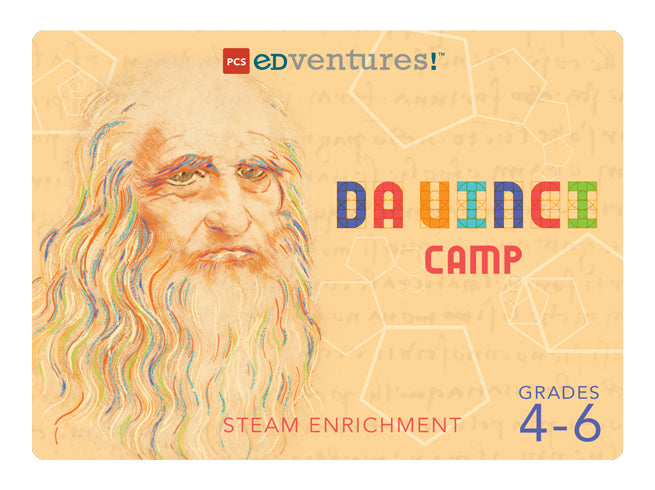
Da Vinci Camp
Pricing Options:
- Complete Program (Materials + Curriculum): 665.00 USD 625.00 USD
- Curriculum Print & Digital: 425.00 USD 395.00 USD
- Refill Kit: 425.00 USD
Recommended Settings:
- Summer Camps
- Classrooms
- Out-of-School Time Programs
- Home Learning
Tech Requirements:
- None
Each Activity Guide Includes:
- Schedule
- Opening & Closing Discussion
- Step-By-Step Activity Instructions
- Topic Background & Vocabulary
- Optional Extension Activities
Curriculum Topics:
- What’s in a Name?
- Mirror Writing
- How to be a Better Observer
- Fractals
- Universal Emotions
- How to Draw a Selfie
- Emoji Story Books
- Woodpeckers
- Alligators
- 3 Perspectives in Cartography
- Ideal City Design
- Mystery Masterpiece Reveal
Product Orientation:
- Half hour free webinar orientation for purchases of $500+
- One hour free webinar orientation for purchases of $1000+
- Additional training available for purchase
Complete Program Includes:
- Instructor Guide: 1
- Student Journals: 31
- Balls of Yarn: 10
- Binder Clips (36 pack): 1
- BrickLAB BrickPack: 1
- Cape: 1
- Colored Pencils (12 pack): 10
- Copy Paper: (500 sheets): 1
- Feathers: 32
- Food Coloring Packs: 2
- Glue Sticks: 10
- Index Cards (100 pack): 3
- Mirrors: 36
- Rolls of Paper Towels: 1
- Paper Cups: 50
- Pencil Sharpeners: 6
- Pencils (12 pack): 3
- Permanent Markers: 36
- Scissors: 10
- Tape Measures: 15
- Access to the Digital Resource Portal
Curriculum Printed & Digital Includes:
- Instructor Guide: 1
- Student Journals: 31
- How to Be a Better Observer Template: 1
- Picture Frame: 31
- Access to the Digital Resource Portal
Refill Kit Available:
Looking to use your Da Vinci Camp Enrichment Program with the next group of apprentices? This refill kit will get them up and running in no time!
- Balls of Yarn: 10
- Binder Clips (36 pack): 1
- Copy Paper (500 sheets): 1
- Feathers: 32
- Food Coloring Packs: 2
- Glue Sticks: 10
- Index Cards (100 pack): 3
- Mirrors: 36
- Roll of Paper Towels: 1
- Colored Pencils (12 pack): 10
- Paper Cups: 50
- Pencil Sharpeners: 6
- Pencils (12 pack): 3
- Permanent Markers: 36
- Scissors: 10
Habits of Mind:
16 thinking habits developed by Art Costa and Bena Kallick to empower students to succeed in a 21st-century learning environment.
- Persisting
- Managing Impulsivity
- Listening with Understanding and Empathy
- Thinking Flexibly
- Thinking about Thinking
- Striving for Accuracy
- Questioning and Posing Problems
- Applying Past Knowledge to New Situations
- Thinking and Communicating with Clarity and Precision
- Gathering Data through All Senses 9
- Creating, Imagining, Innovating
- Responding with Wonderment and Awe
- Taking Responsible Risks
- Finding Humor
- Thinking Interdependently
21st Century Skills:
A set of widely-applicable abilities essential for success in the information age.
- Creativity and Innovation
- Critical Thinking and Problem Solving
- Communication and Collaboration
- Information, Media, and Technology Literacy
- Flexibility and Adaptability
- Initiative and Self-Direction
- Social and Cross-Cultural Skills
- Productivity and Accountability
- Leadership and Responsibility
© 2019 Battelle for Kids. battelleforkids.org. All Rights Reserved. Battelle for Kids was not involved in the production of this product and does not endorse it.
Common Core State Standards for Mathematics:
- CCSS.MATH.CONTENT.4.G.A.1: Draw points, lines, line segments,
rays, angles (right, acute, obtuse), and perpendicular and parallel
lines. Identify these in two-dimensional figures. - CCSS.MATH.CONTENT.4.G.A.3: Recognize a line of symmetry for a
two-dimensional figure as a line across the figure such that the figure
can be folded along the line into matching parts. Identify
line-symmetric figures and draw lines of symmetry. - CCSS.MATH.CONTENT.4.MD.A.2: Use the four operations to solve word problems involving distances, intervals of time, liquid volumes, masses of objects, and money, including problems involving simple fractions or decimals, and problems that require expressing measurements given in a larger unit in terms of a smaller unit. Represent measurement quantities using diagrams such as number line diagrams that feature a measurement scale.
- CCSS.MATH.CONTENT.5.G.B.3: Understand that attributes belonging to a category of two-dimensional figures also belong to all subcategories of that category. For example, all rectangles have four right angles and squares are rectangles, so all squares have four right angles.
- CCSS.MATH.CONTENT.6.RP.A.1: Understand the concept of a ratio and use ratio language to describe a ratio relationship between two quantities.
© Copyright 2010. National Governors Association Center for Best Practices and Council of Chief State School Officers. All rights reserved.
Common Core State Standards for English Language Arts:
- CCSS.ELA-LITERACY.RF.4.3.A: Use combined knowledge of all letter-sound correspondences, syllabication patterns, and morphology (e.g., roots and affixes) to read accurately unfamiliar multisyllabic words in context and out of context.
- CCSS.ELA-READING LITERATURE.R.L.4.4: Determine the meaning of words and phrases as they are used in a text, including those that allude to significant characters found in mythology (e.g., Herculean).
- CCSS.ELA-LITERACY.SL.5.5: Include multimedia components (e.g., graphics, sound) and visual displays in presentations when appropriate to enhance the development of main ideas or themes.
© Copyright 2010. National Governors Association Center for Best Practices and Council of Chief State School Officers. All rights reserved.
Next Generation Science Standards:*
- NGSS MS-ETS1-3 Engineering Design
- NGSS MS-LS1-5 Growth and Development of Organisms
- NGSS 3-5-ETS1-1 Engineering Design
- NGSS 3-5-ETS1-2 Engineering Design
- NGSS 3-5-ETS1-3 Engineering Design
- NGSS 4-LS1-1 Structure and Function
*Next Generation Science Standards and NGSS is a registered trademark of WestEd. Neither WestEd nor the lead states and partners that developed the Next Generation Science Standards were involved in the production of this product, and do not endorse it.
National Core Arts Standards:
- VA:Cr1.1.4a: Brainstorm multiple approaches to a creative art or design problem.
- VA:Cr1.1.5a: Combine ideas to generate an innovative idea for art-making.
- VA:Cr1.1.6a: Combine concepts collaboratively to generate innovative ideas for creating art.
- VA:Cr1.2.4a: Collaboratively set goals and create artwork that is meaningful and has purpose to the makers.
- VA:Cr1.2.5a: Identify and demonstrate diverse methods of artistic investigation to choose an approach for beginning a work of art.
- VA:Cr1.2.6a: Formulate an artistic investigation of personally relevant content for creating art.
- VA:Cr2.1.4a: Explore and invent art-making techniques and approaches.
- VA:Cr2.1.5a: Experiment and develop skills in multiple art-making techniques and approaches through practice.
- VA:Cr2.3.6a: Design or redesign objects, places, or systems that meet the identified needs of diverse users.
- VA:Cr3.1.6a: Reflect on whether personal artwork conveys the intended meaning and revise accordingly.
National Core Arts Standards © 2015 National Coalition for Core Arts Standards. Rights administered by Young Audiences, Inc. New York, NY. https://www.nationalartsstandards.org
Beth Schadd
Hailing from Wisconsin, Beth Schadd moved to Idaho in 2008 in search of adventure and a Master’s degree in Environmental Science and Education from the University of Idaho. As an educator, she has worked with children of all ages in the outdoors and the classroom, as well as coaching various sports.
Beth has developed experiential curriculum for science centers, museums, day camps, and outdoor programs. In 2013, she traveled to China to lead outdoor and adventure camps. Prior to moving to Idaho, Beth worked in labs studying mosquitoes and environmental health, and managed clinical trials. Though she will always be a Cheese Head at heart, she has embraced the great outdoors of the West, enjoying snowshoeing, mountain biking and backpacking, and has become an avid stand up
paddleboarder.
We have really enjoyed teaching this curriculum and our students have thoroughly enjoyed learning about DaVinci the polymath!
Thank you for your review! We’re happy to hear that you and your students are having a great time with Da Vinci Camp.







